2/6/18
Highlights Walking the gorge and then the evacuation point.
We left as planned at 8.30am, with
plenty of water, as we were heading for Imbros to walk down the famous gorge, following
the path of the Allied soldiers who evacuated down through here after the Battle
of Crete. We were all looking forward to the day as it is also one of Sue and Jules
favourite walks that they have done about 15 times now. In 2015, they walked
down with Ro and Libby and placed caches so we also had a few of these to find.
We stopped by a taverna at the top for coffee
and a loo stop before following the path to the start of the gorge. Later we
found that there is an official area as well where we could have started but
ours worked well. Our first cache was set by Ro and was both a quick find and
gave the NZ history of the evacuation. I am copying her listings as it is an
excellent summary.
She wrote ‘Talk to many Kiwis about the experiences of their father or grandfather
during World War II and Imbros Gorge will come into the conversation. Imbros
Gorge (Faragi Imbrou) is an 11 km long canyon in southern Crete. Its
narrowest part is just 1.6 m wide and it ends at the village of Kommitades
(an 8 km/ 650 m walk). The Imbros village (aka Nimbros) is located at
an altitude of 780 meters and is at the South end of the fertile plain of
Askyfou. The Imbros Gorge mule trail was the only connection between Chania and
Hora Sfakion, before the road was built. Remains of this trail can still be
seen. The gorge witnessed an evacuation of several thousands of British,
Australian and New Zealand soldiers during World War II.
Having suffered defeat
at the hands of the Germans, troops retreated to beaches on the south coast
where they were rescued by waiting ships and transported to Egypt.’
While much of the walk was over new
stones/gravel, there were parts where we were walking on the old donkey trail.
That part was often easier to walk on, although we had to watch out for stones
made slippery by the feet of ages. There
was one section in the middle where it was both narrow and the swirl of water
had made the surfaces very slippery and I was excessively cautious, perhaps
because a woman before us had slipped a few minutes earlier in a much less slippery
spot.
Early into the walk we were being overtaken
regularly by what we assumed (correctly) were people on a coach trip. We were
taking our time and stopping often for photos, to admire and to reflect. The
height of the gorge side was awe inspiring and the trees growing out of what
seemed like sheer walls had us puzzled as to where they were getting any nutrients.
There were caves in the walls and lots of flowers.
We were always happy to stop
to let people pass as it gave us more opportunities to look. We were so pleased
we were under no time pressure.
At the middle of the gorge was a very random
hut. John’s reference to Imbros Hilton even had the other people who had
stopped here smiling. We had been warned not to use the nearby toilets which we
were told would be smelly and full of wasps. We didn’t bother to check this
out, given the number of wasps hanging around the rubbish bins. The gorge had
bins at regular intervals, mainly filled with empty water bottles, and there
were a number of ‘no smoking’ signs.
Sue and Jules had placed a number of caches
in the gorge and we were also happy to stop and sign logs. It was also a form of
cache check for them. We passed a small memorial and soon after found the cache
linked to it further down the gorge. It was a ‘Sorry Tale’, which is what they
called the cache. During the Turkish occupation of Crete, a Greek family hid in
a nearby cave. The cave was found, blocked and set alight.
We had brief chats with others walking down
and passed others walking up. Although down was the better option, the route up
would have been achievable as the gradient was gentle overall. One couple from
Germany had a toy hedgehog in their pack. Others were from Belgium, and we also
heard a few native English speakers as we descended.
The cache near the bottom was called ‘Almost
there’. Sue and Jules explained that the lower hut used to be closer to this
cache but has since been moved. There are huts at each end, where you first buy
your ticket to walk and later have it checked. After 2 people died on the
Samaria Gorge, there had been an uproar that their absence had not been noticed
until someone actually found them, one dead and one badly injured but later dead
before medical help could come. We are not sure how closely the tickets are
checked as it would be possible to leave the track before the bottom hut.
The final gorge cache also belongs to Sue and Jules
and they told us about it as we neared the end of the walk. By then the
overhead sun was hot and we were ready for the end, so the name, ‘End or
Beginning’, was easy to remember. They had placed it some time ago, and the hut
man had spotted a number of people heading in to it and wondered. So he went
and found it, and decided it was in the wrong place so moved it to a better
place. He then happily showed cachers where it was. When the logs told Jules and
Sue it had been moved they went to check.
It was not where they had placed it
so they approached the office. The man tossed a rock and told them that was
where the cache was. The rock did basically land on the cache in its’ changed
position. Sue tried to explain that she had placed it and wanted it back where
it had been, but decided her Greek was not good enough to explain about GPS coordinates!
So she took a new reading and left it in its new spot. We were introduced to
the man at the hut and then headed off to find it. The man at the office was very, very keen to help. We went
slightly in the wrong direction and were rapidly redirected from a distance.
The help was not really needed as the GPS did read 0 when we picked up the
cache. In the meantime, he had explained to Sue that he did let people
try to find it themselves and only helped when they were going wrong!! True,
but his idea of the time when people were going wrong was very short.
We went into one of the Tavernas where Jules was
greeted as ‘Lamb Chops’. They always go here after a walk and are now considered
‘their best customers’.
In fact, at one stage the owner thought they were tour
guides as they came so often with others like us. After three beers and one
orange juice (that hardly touched the sides), our meals came, and so did some
extra drinks. Yes, Jules had lamb chops. John had fish which was both big and
tasty. Our hosts said they would never have thought of having fish here as it
is an agricultural village though right by the sea, but maybe next time Jules
will shock them.
When we had nearly finished our meal we noticed the coach below which had filled up was still sitting there. A woman who appeared to be a guide then entered the taverna we were in and checked it out. We had started to assume they were looking for someone. Then we saw a man enter looking very wobbly. He headed down and we saw him being taken across the road to the coach. We were very appreciative of starting a little earlier, having lots of water (although not all was used) and a snack bar in the middle and never having to rush.
We had walked 10km but now went 18km by road back to our car at the top in the pickup the taverna owners use as a taxi service.
Later we saw
a German couple who had walked up the gorge walking back down the road. We don’t know if it
was a fitness campaign or for economy to avoid the 5 euro trip by truck but the
woman looked very fed up. We felt it was excellent value but if we had not done
this we would have preferred the gorge walk to the hot winding road walk.
We went back on the road as Jules drove us to
Sfakia, the port where the rescued troops were picked up by navy destroyers and shipped
to Alexandria. There is a lovely bronze memorial to them here. It says “From
this Bay between 28th May and 1st June 1941 the last
Australian, British and New Zeland forces which fought alongside the Greek
Forces in the fierce struggles of the Battle of Crete against the Germans were evacuated
by British and Australian Warships”. There were the flags of Greece, the UK, NZ
and Australia hanging above them, a relief map showing the route they had taken
from Maleme, and details of the casualties. On June 2 2018 this was a very
peaceful village.
We stopped for very welcome ice-creams and
watched a few ferries leave the Bay. Some connect the coastal villages and some
still go to Alexandra from here. It was far too hot to do the cache in the
village but I did find a couple as Jules drove us back up the hill. One was
theirs and talked of the old road which had been 1 way and wound around the
hillside. The new road is 2 way, includes some tunnels and winds down just like
a scalextric car
set as Jules described it. The new road had looked
very interesting on the GPS map as we had walked the gorge, but the many turns
allow a gentle drop down to the villages below.
We headed home as we were all ready for a
break from the sun. After dropping John off, the three of us headed out briefly
for a cache as it was a caching day that ‘the Cretan Runners’ had blank in their calendar.
It was at a church, which is not really surprising.
Then we went back and were ready for a rest when the
phone rang. Their best friend Paul had had a motorbike accident, (his wife is
in the UK having cancer treatment) and he was clearly in shock.
So they headed
out immediately to support him. We had a phone call later to say he was in Chania
hospital and going to be admitted with an open fracture of his foot. We had
discussed treatment in Crete and knew that nursing services were limited so did
not expect them back until late. We had cheese and crackers and were sitting inside when they
arrived back and also had cheese and crackers and a glass of wine. Paul’s Greek
neighbours had insisted on an ambulance being called and had later turned up at
the hospital themselves. That helped, as they were far more familiar with the
system. In the mean time Paul’s wife was contacted and was furious because he had been on the
bike in flip flops. Sue and Jules are going to go to his house tomorrow to
collect clothes etc for him and we said we would have a lie in, let them get
sorted and see them when they got back.

 Chania, Greece
Chania, Greece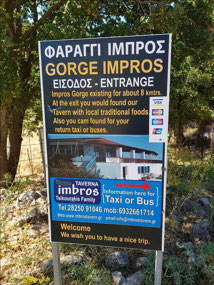
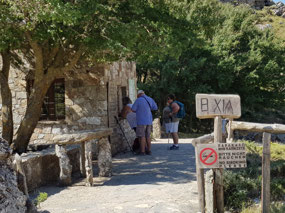

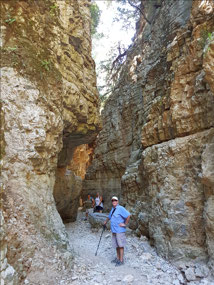
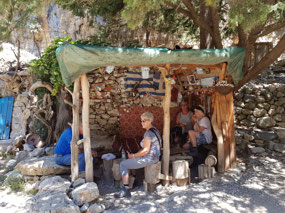
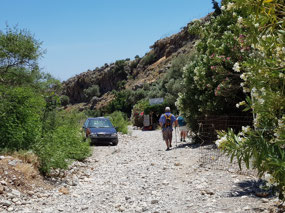
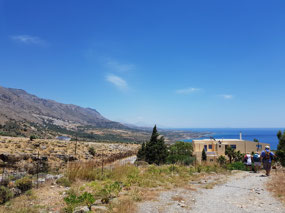
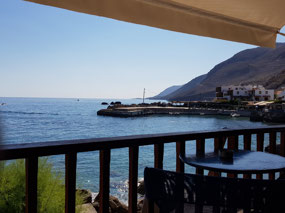
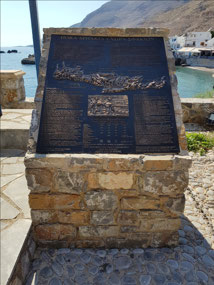






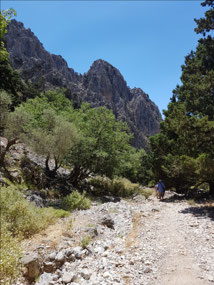

Ro
2018-06-03
I remember thinking quite a lot about 1941 as we descended. The bit that gets me as I read it now is that they were evacuated to Egypt...and for most of them I suspect, more horrors.